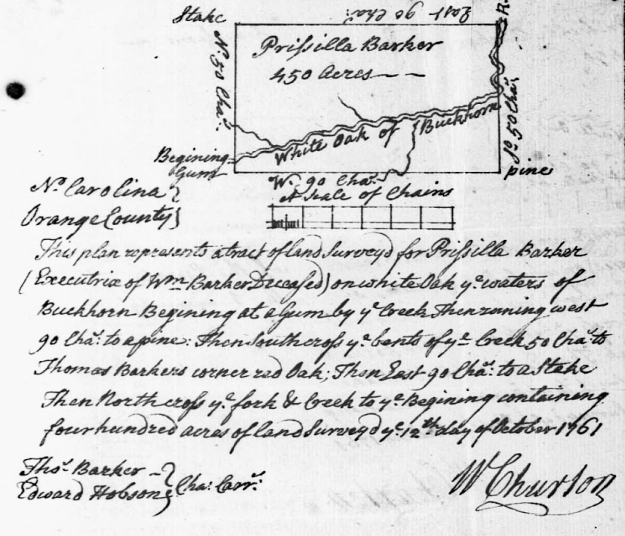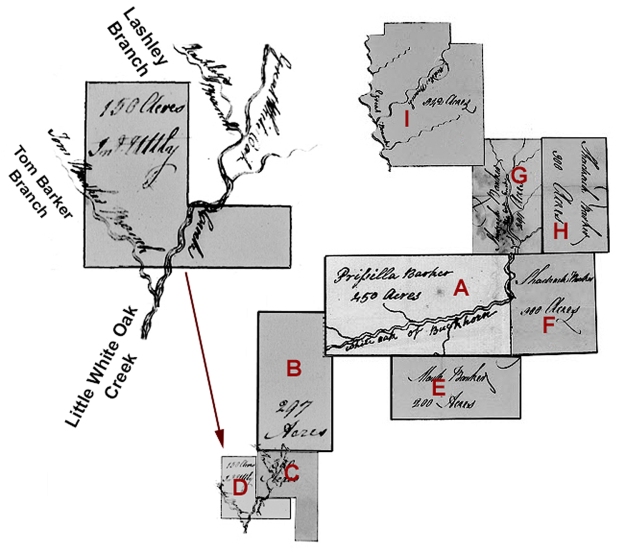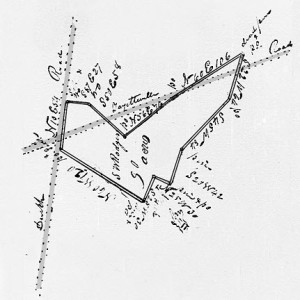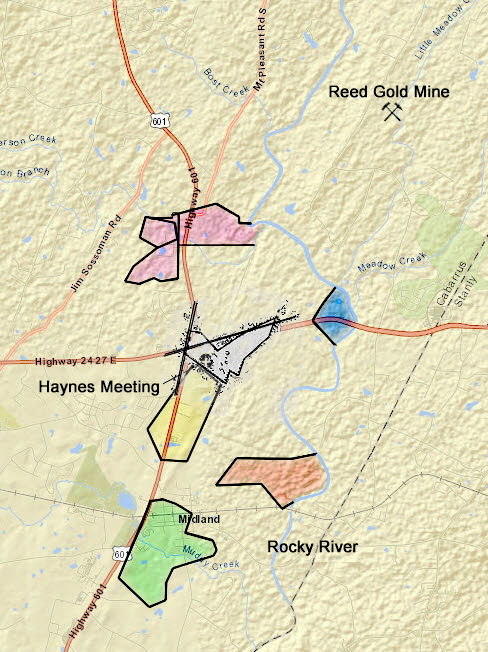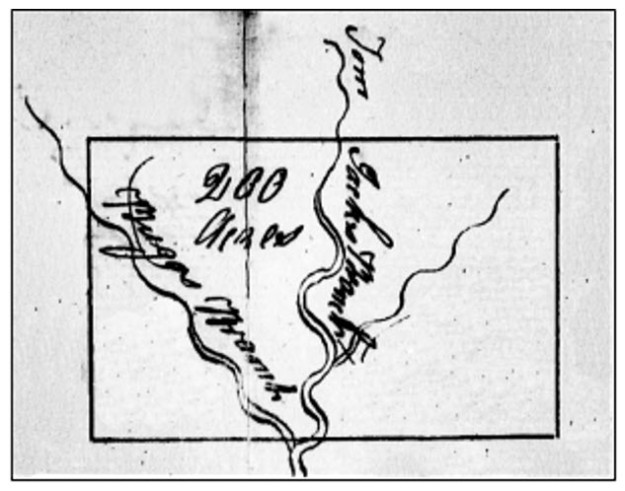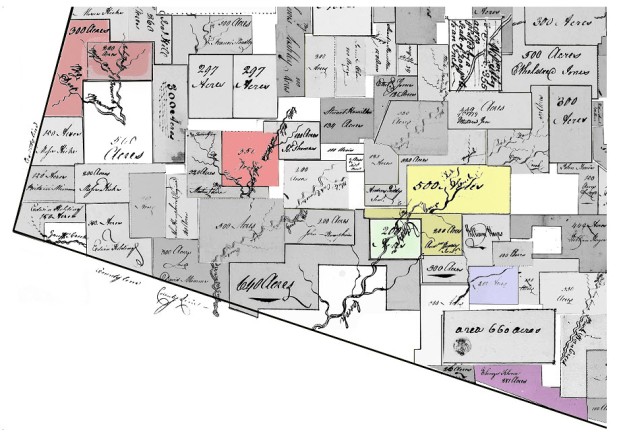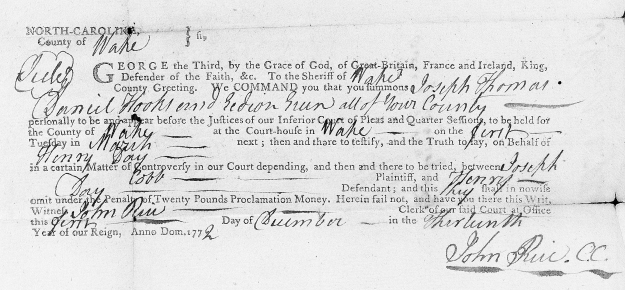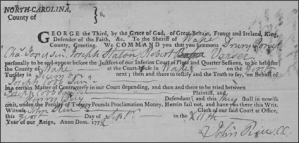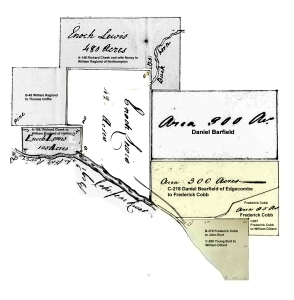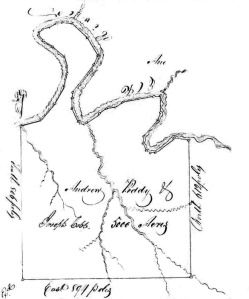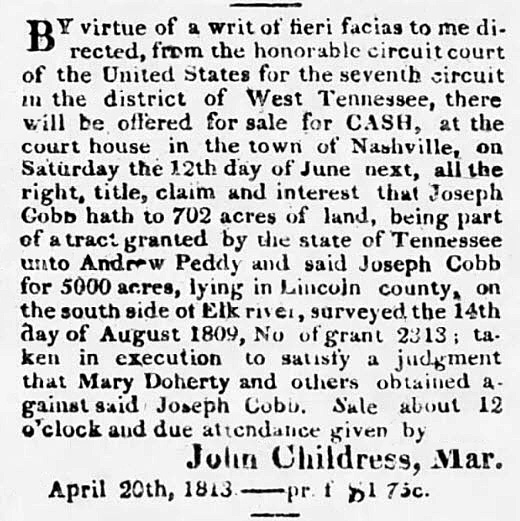Seated in his Logan County, Kentucky home, John Powers penned a passionate plea addressing the Governor and the People of Tennessee. Governor John Sevier is no ordinary man as he was a famed Indian fighter, a leader of Over Mountain men serving in the Battle of Kings Mountain, and a statesman important to the founding of Tennessee. John Powers levied his concerns against the said John Sevier:
“As no doubt, from the exalted station you occupy; from the distinguished confidence your fellow citizens have reposed in you, you must be a just man, and a true republican; I take the liberty of offering to you, through the medium of the public papers evidence sufficient, in my opinion, to convince you, or at least the public, that you do unjustly, and contrary to right, hold in your possession, and detain in slavery, a certain woman of color, by the name of POLL LUCOST [Lucas], with her three children.”
An amazing letter, this is unlike any I have ever read as John Powers seemingly risked all on behalf of an apparently beloved family of color he referred to as being friendless. Assuming John Powers to be racially white and as expressed in his own gentle word, it seems much was at stake as he and Poll Lucost were raised in the same household. Concerning Poll’s mother and the rest of her family:
“…they are friendless; the voice of humanity and justice is too feeble to call forth the energies that are necessary to contest in a tedious lawsuit with a man possessed of the great personal influence of the governor of Tennessee ….having been raised in the same family with Poll Lucust, from infancy to manhood, and well knowing her justly entitled to her freedom, when I found you determined to keep her as a slave – I caused a suit to be instituted against you, at Jonesborough, about three hundred and sixty miles from my house.”
Seeking to sway public sentiment in a suit he apparently raised 360 miles to the east in Jonesborough, Washington County, Tennessee, John Powers addressed the public and Governor through a lengthy letter he published August 22, 1804.
Who is Poll and who is the said John Powers? Firstly, Mary Lucost is the mother of the above-mentioned Poll Lucost, and Mary’s other children are Val and Austin Lucost. Mary was always considered a free woman and remained legally free though out of necessity she bound herself by indenture to Thomas Barker for a term of seven years which court document John Powers stated he had in his possession. Mary died before her seven-year indenture matured and little of her, her children, and others is known prior to her death.
From the letter we learn of Thomas Barker’s brothers and of their father William. Some say Thomas is the son of Joel Barker but that cannot be true. Thomas Barker may have been a contemporary to Poll Lucost as the two appeared to grow up from infancy alongside each other in the same household. Since from deposition Thomas Barker is said to be the son of William Barker, then Poll, surely lived in the same home alongside her mother Mary Lucost and the rest of her immediate family. Mary Lucost and her family moved somewhere west, beyond the Yadkin River, with the family of Thomas Barker where I believe she likely died ca. 1770 -1790. Thomas Barker’s wife, Ann, stated she knew Mary Lucost, the mother, for a term of eight to ten years prior to the death of the said Mary Lucost. Ann’s first knowledge of Mary Locust may go back to Wake County during childhood or possibly later, during a time they lived somewhat together beyond the Yadkin …being a time Ann was married to Thomas Barker.
Thomas Barker, who married Ann, cannot be the person of same name who died ca. 1763 and whose children Ephraim and William sold their rights to neighbor Christopher Osborne. I tried in earlier posts to make that connection though timing simply does not work. Realizing Thomas Barker, as mentioned in the letter, is contemporary to Mary Locust’s daughter Poll, how do we connect him to his father, William Barker, as was also declared? Let’s dig a bit deeper.
Issued in 1761 Orange County, North Carolina, the above appears in the survey for “Prissilla” Barker’s 450-acre grant. Some say Priscilla is the wife of Thomas Barker who died a year or so later though customarily she would not be the executrix for another man, William Barker, if that were the case. Priscilla is indeed the wife and widow of William Barker, deceased. And following her husband’s death, the widow Barker married Samuel Letman and in 17?? and registered in 1787, the said Priscilla Letman deeded “to my loving son Mark Barker, being my lands and plantation whereon said Mark Barker now dwells,” 125 acres bounded by a line of agreement made between myself and my son William Barker crossing White Oak Creek and Rocky Ford (deed H-65, Wake). The tract is “the upper part of [Priscilla’s] certain survey of 450 acres.” Witnesses to the deed were Brittain Utley and Lewis (X) Barker. Such documentation is important and should not be overlooked.
Overwhelmingly stated in depositions revealed in John Powers’ 1802 letter, and supported through documentation, it is clear beyond discussion that Priscilla is the wife and widow of William Barker who died prior to 1761. And from the deed description above, we now know that the deceased William Barker is the father of both Mark Barker and William Barker. Furthermore, one must question Lewis Barker who witnessed the aforementioned deed. This is especially true as depositions from John Powers’ letter verifies that William and Priscilla’s sons Mark and William Barker have a brother named Lewis Barker. Surely Lewis Barker who witnessed a transaction by his mother is the same Lewis Barker who was deposed and gave statement per John Powers’ letter. Finally, serving as witness in the above-mentioned deed is Brittain Utley, the son of John Utley who also testified per the letter. All the players are in place though one question remains, …who is Thomas Barker?
From the survey for Priscilla’s 450-acre grant which was likely entered by her deceased husband William Barker, not only did a person named Thomas Barker serve as chain bearer, but the land itself is described as joining the lands owned by “Thomas Barker.” That fact is magically given genealogical meaning by family historians as in a 1778 caveat, being a mechanism for resolving a legal land conflict, we learn that a person named Thomas Barker died ca. 1763. And as already stated, this deceased Thomas Barker once owned land adjoining that of Priscilla Barker’s 450 acres. Who is Thomas Barker?
Firstly, Thomas Barker who died ca. 1763 cannot be the son of William and Priscilla Barker as their son of that name appears prominently as a deponent per the letter written by John Powers in 1802 Kentucky. That Thomas Barker, alive and well in 1802, is legally identified through depositions by his brothers Mark and Lewis. It is possible the same Thomas Barker who moved to Kentucky could be the one who served as survey chain carrier and whose land in 1761 adjoined that of the widow Barker’s 450 acres. If so, he would have likely been one of the older children in William and Priscilla’s family if not the oldest. Even so, I struggle with the idea that such a person born ca. 1740 would have been gallivanting around Middle Tennessee and Logan Kentucky during the early 1800’s though records undeniably point in that direction.
On the other hand, I think it is equally plausible that Thomas Barker whose land adjoined that of Priscilla in 1761 is the same as he who died ca. 1763. That person cannot be successfully linked to the tree (see green lineage in familytree near bottom of page). As for William and Priscilla Barker’s son Thomas, maybe born a bit later, he avoids record before leaving Wake County with the indentured Mary Locust and family.
There is one last possibility worth considering as it is known that Thomas Barker who died ca. 1763 left a wife and sons William and Ephraim, who I’ve found later in now Cabarrus County, North Carolina. What if Thomas Barker’s wife, name unknown, gave birth to the two sons and yet had a younger child named Thomas for their father? Such a child could have been raised by an uncle or maybe his grandmother and therefore being given a family heritage based on love and not blood. Maybe this child was not truly the son of William though for the most part he could have been raised by his Uncle William Barker. Such thinking is a stretch though the suggested possibility does exist. For now, I’ll move on as I do not want to get bogged down in piecing together a troubled genealogy that may be conflated in the very real possibility that early ancestors lived in hard times only to be made whole through undocumented love and the care of neighbors and family.
Getting back to Mary Lucost and her son Austin Lucost, from the letter, “he [Austin] lived on the waters of Holton [Holston River] as a free man.” Austin Locust purchased his wife, (name not given in the letter) from Governor John Sevier. From a lone deed in Jefferson County, Tennessee, Austin conveyed “seventy-five acres [on the north side of Mays Mountain] on which I now live, in consideration of the love and good-will I have and bear toward the said Hodge and Vance.” Austin deeded his rights back to the two men who originally, and possibly graciously, “secured the said land to me [Austin] during my life-time and during the life of my wife Rachael.”
It is apparent that Governor John Sevier somehow encountered the Lucost family in such a way leading to the enslavement of the formerly free Poll Lucas while also selling to her brother [the free Austin Locust], a slave named Rachael who became the said Austin’s wife. Complicated. And as for their brother Val Lucost, John Powers further stated that Mary Locust’s son “Val Lucust lives in North Carolina, as a free man, no body pretending to set up any claim to him.” That statement is not wholly true as three years prior to publishing the letter, in 1801, the following was published in Raleigh, North Carolina.
[Raleigh Register, 6 October 1801]
FREE NEGRO STEALERS.
On the 29th Instant, about Mid’ Night, four Men came to the House of VALENTINE LOCUST, an aged Free Negro, who resides on Leek Creek, in Wake County, and calling at the Door to gain Admittance, as soon as the Door was opened, Two of them entered with Clubs, and instantaneously knocked down the old Man and his Wife, and beat them to such a Degree as scarcely to leave Life; and whilst they were in that Situation, the Robbers carried off two of their Children, a Boy named Absalom, aged about twelve Years, of a yellowish Complexion, who is just able to read and write; a Girl, named Polly, aged about five Years, of a Complexion more yellow than her Brother.
The Father of the Children is a respectable and industrious old Man, who has hitherto made ample Provisions for himself and Family; and it is hoped, from the peculiar Circumstances of his Case, arising from his Incapacity to bear Witness, except against his own Colour, added to the distressed situation he must be place in after the Loss of his two Children, will awaken the Feelings of the Humane, and that they will contribute every Thing in their Power that may tend to the detecting and punishing of such vile Offenders.
It is supposed the Perpetrators of this Offence, will endeavor to convey their Prey to the State of Georgia, in the Character of Slaves, for the Purpose of Traffic. Wake County, N. Carolina. Sep. 30, 1801
[The Printers in the U. States who are desirous of detecting the Offenders, will give this a Place in their Papers.]
 In 1801 Valentine Locust was considered to be “an old man” and a free person of color living somewhat normally in Wake County. He was not alone as numerous free families of color in our county ca. 1800 were impacted by the worsening black codes. This is an interesting population, one seldom written about.
In 1801 Valentine Locust was considered to be “an old man” and a free person of color living somewhat normally in Wake County. He was not alone as numerous free families of color in our county ca. 1800 were impacted by the worsening black codes. This is an interesting population, one seldom written about.
Among the mixed-race citizens were several named Valentine, whether used as a given or surname. Additionally, in 1807, a person named Nancy Valentine posted a newspaper (right) notice concerning three of her children who had been taken near Fish Dam Ford on the Neuse River (present-day area of Falls Lake).
Nearby, in 1784, another person of color identified as Valentine Austin of Franklin County, first appears in Wake County when he purchased 100 acres on a branch of Fall Creek from Nathaniel Bridges. It appears the area surrounding Fish Dam Ford in northern Wake was particularly brutal as period newspaper notices account for numerous horse thefts and missing wallets as well as people of color who were believed to have been taken. It seems most of the people of color passing through northern Wake County had ties back to Franklin and other counties to the east.
Later, in 1798, the same Valentine Austin mentioned above purchased 100 acres in southwest Wake County from William Love to whom the land had been originally issued as a grant during the same year. “Leek Creek” as identified in the notice may have been Lick Creek or Branch, of which there are many such ephemeral streams in Wake County. However, I believe odds are good that the stream where Austin Locust lived in Wake County forked off Cary’s Branch near the lands of Peddy and Utley in southwest Wake. Many, both Black and White, who first lived in the northeast of Wake County, eventually moved or bought additional lands in the south.
Valentine Locust, son of Mary as written in John Powers’ letter, served in the Revolutionary War. Rachael, his wife and widow, filed for a pension in the 1830’s. We know that Valentine enlisted 26 Apr 1776 for 2 ½ years in 2nd Company, North Carolina Battalion. Soldiers were paid in land since North Carolina was land rich though money poor. For his service, Valentine Locust received warrant No. 782 in 1784, for 228 acres of land situated on Spring Creek of Red River in Robertson County, then Davidson County, Tennessee. Spring Creek rises in an area geographically known as “the Barrens” or Barren Plains before emptying in the Red River near the Logan County, Kentucky line. Of all people and of all the places, Valentine’s acquisition of land in 1784 connects to people who are later mentioned in John Powers’ public plea.
Looking deeper into the letter published by John Powers, all remembered Mary Locust as being an old lady of color who passed as free. Witnesses confirmed her children were as she had stated, and she was neither Black nor White as they had always heard her mother was “Indian.” Lewis Barker stated that Mary Locust went from Wake County with his brother Thomas Barker to the Yadkin River, where he, Lewis Barker, saw her some other time.” People were clearly in motion.
Mark Barker stated that Mary Locust formerly lived with his mother and that he had also seen Mary’s two daughters on the Yadkin with his brother Thomas Barker. Note that the Yadkin River is long, rising near Blowing Rock in North Carolina, flowing southeast to join the Great Pee Dee in southern Stanly County. The families could have set up a home anywhere along the river’s path. But also, during this time was the Revolutionary war and what impact did that have on those who had only recently moved and settled? Reviewing grants and deeds in the numerous counties along the river’s path, I have not found any documentation clearly identifying where Thomas Barker settled before coming to Tennessee. Furthermore, John Utley stated that he was acquainted with Mary Lucost some forty or fifty years back (ca. 1752-1762) while she lived with “old Mr. William Barker,” father of Thomas Barker, with whom she removed from the county of Wake to the Yadkin River.
Appearing before justices West Maulding and Richard Boyce at the home of Clayton Talbot in the town of Russellville, Logan County, Kentucky, John Powers, Celia Maulding, Thomas Barker and Anne Barker his wife also provided statements. As for John Powers, we learned he “is the son of Mrs. Thomas Barker,” indicating that the said Thomas’ wife Ann had likely been previously married. Ann Barker knew of Mary Lucost for 8-10 years prior to the death of said Mary. As earlier discussed, was Ann married to Thomas Barker when she met the said Mary, or did she know of Mary beforehand, maybe in childhood?
Illustrating the impact of the governor’s actions, John Powers stated in his letter that the children of Mary Locus’ daughter Betsy “were held as slaves by Wm M’Ado, who publicly, in Robertson County court, at two different times, acknowledged their freedom and had them bound to him as poor orphans.” Thomas Barker further stated that “the said Mary [Locust] voluntarily indentured herself to him, for the space of seven years, in consideration of the payment of twenty-one pounds, by, this deponent, to the use of the said Mary; and the said Mary died before the expiration of the said term of seven years.” That he, Thomas Barker, never held said Mary as a slave. And finally, from depositions revealed in the letter, Thomas Barker’s wife Ann and their daughter Celia Mauldin spoke to birth and the legitimacy of Mary’s grandchildren.
 Turning the page and moving west, Thomas Barker, named in John Power’s letter, can clearly be found in Logan County Kentucky as well as Robertson County, Tennessee. Not only there, but a person of that name seems to appear a bit to the south in Dickson and later Hickman County. In fact, what I see in land documentation may represent two or more branches of the extended Wake County, North Carolina Barker family who settled in Tennessee over a period of time (more later). However, and back to Thomas Barker who appeared in John Power’s letter, the area where he first settled in Tennessee was situated along the western extent of the Tennessee/Kentucky State line on the south fork of the Red River in a geographical region called the Barrens. The Barker family married into the Maulding family who, in 1780, built a stockade along the Red River called “Mauldings Fort” in fear of attack by the Indigenous people. Nearby is also the site of Red River Meeting House, where the first-ever religious camp meeting was held in America in June 1800. Organized by Presbyterian Minister James McGready, thousands of hungry souls gathered at the 1800 Meeting which marks the important start of the Second Great Awakening.
Turning the page and moving west, Thomas Barker, named in John Power’s letter, can clearly be found in Logan County Kentucky as well as Robertson County, Tennessee. Not only there, but a person of that name seems to appear a bit to the south in Dickson and later Hickman County. In fact, what I see in land documentation may represent two or more branches of the extended Wake County, North Carolina Barker family who settled in Tennessee over a period of time (more later). However, and back to Thomas Barker who appeared in John Power’s letter, the area where he first settled in Tennessee was situated along the western extent of the Tennessee/Kentucky State line on the south fork of the Red River in a geographical region called the Barrens. The Barker family married into the Maulding family who, in 1780, built a stockade along the Red River called “Mauldings Fort” in fear of attack by the Indigenous people. Nearby is also the site of Red River Meeting House, where the first-ever religious camp meeting was held in America in June 1800. Organized by Presbyterian Minister James McGready, thousands of hungry souls gathered at the 1800 Meeting which marks the important start of the Second Great Awakening.
In an earlier post I commented on the merciful tone of John Powers’ letter. It turns out the observation is spot-on as John Powers was a Methodist preacher. As will be shown in a little more detail, John Powers eventually moved to Bond County Illinois, where in February 1816, he preached a sermon at Fort Jones. Powers was also one of the first judges in Bond County, Illinois.
Back to Thomas Barker, did he settle only on the Red River, or was his movement west punctuated by earlier stops along the way? Did he make other land purchases in Tennessee? Did Thomas Barker move to Tennessee near the turn of the 19th century or was he there earlier, possibly during or shortly after the Revolution? What do we know of him prior to Logan County Kentucky and of all people, how did Poll’s children end up in the hands of powerful John Sevier, who lived 360 miles to the east in Washington County, Tennessee? Since this Kentucky fellow is not Thomas Barker who died ca. 1763, then what is his story from the time he left Wake with Mary Lucost, the person of color who he indentured?
As a starting point, it is known that John Powers, Thomas Barker, and Thomas’ wife Ann provided statements at the same time at the residence of Clayton Talbot in Russellville, Kentucky. But earlier, in then Tennessee County, near the “western boundary of Sumner County and the Virginia line”, being in May 1789, a person named Thomas Clark received a military warrant (Deed A-92, Montgomery County TN) for 128 acres on north side of the Red River and on the east side of “Thomas Barker’s plantation” on the “Barren.” So, it appears Thomas Barker had a plantation in Tennessee, early on, prior to 1789. Note that Middle Tennessee rapidly divided following the end of the Revolution with Tennessee County forming from Davidson followed by Robertson from Tennessee. Then was Montgomery, Stewart, Hickman, and Dickson to the west.
In Oct 1799, Thomas Barker of Robertson County Tennessee purchased 100 acres situated on the state line on the forks of Red River in Logan County, Kentucky. This land was initially granted to Solomon Perkins in 1796. And then in Oct 1801, John Powers of Robertson County TN sold to Lewis Barker “of same,” 200 acres on the fork of the Red River (Deed A1-568, Logan KY) joining Thomas Barker and Lewis Barker. I guess it is possible two unrelated families of Thomas and Lewis Barker could have acquired adjoining lands without sharing kindred relations though such coincidence is highly unlikely. This deed from John Powers is used to declare Thomas Barker the father of said Lewis Barker per an article in the August 1932 issue of the N. C. Historical and Genealogical Record. So, at the very least we know from the deed that Thomas Barker and Lewis must somehow be related. Furthermore, we know John Powers and Thomas Barker owned adjoining lands and signing in witness was none other than William Mc’Ado, the fellow to whom John Powers expressed disdain in his letter directed at Gov. John Sevier:
“Your example in detaining Poll and her children, has had a very fatal effect in Logan County Kentucky, where three of Betsey’s children are held as slaves, under Wm M’Ado, who publicly, in Robertson county court, at two different times, acknowledged their freedom and had them bound to him as poor orphans.”
In Jun 1802, Thomas Barker, Anne Barker his wife, Celia Maulding, and John Powers, were called to the home of Clayton Talbot by justices West Maulding and Richard Boyce to testify “in a certain matter of controversy” where Ninian Edwards was plaintiff and Morton Maulding defendant. Justice West Maulding was Thomas and Anne Barker’s son-in-law as he married the above-named Celia Barker in 1793. Furthermore, Ninian Edwards happens not to be your ordinary run-of-the mill plaintiff. Settling in Logan County about the time of this court action, Ninian held the rank of major in the Kentucky militia. He was a circuit judge and by 1806 became chief justice of Kentucky’s Court of Appeals. Ninian Edwards became governor of the new state of Illinois in 1809 where he later served as senator from 1818-1824.
Curious concerning the above court actions, the year following Lewis Barker’s purchase of land from John Powers, I learned that Logan County deeds record the March 1802 indenture of Betsy Lucas and her four children to none other than Ninian Edwards. Central to John Powers’ letter and occurring only three months prior to Ninian’s “certain matter of concern,” Betsy’s named children in the deed are the same as those appearing in John Powers’ letter:
James Lucas – aged about sixteen years
Austin Lucas – aged about thirteen years
Moses [Mote] Lucas – aged about ten years
Hannah Lucas – aged about fourteen years
I have pondered much about Betsy and her children, of how they fell into the hands of Gov. John Sevier. From the hands of common citizenry living hundreds of miles away, finding a plausible social mechanism leading to the forbidden acquisition has been quite vexing. And now, here we see the family of color indentured into the hands of Ninian Edwards who certainly moved within the same circles as Governor John Sevier. Maybe the indentured family moved from Lewis Barker to the powerful Ninian Edwards before becoming the tainted property of the Governor of Tennessee? The timeline of events from the Lucas family indenture to appearing in John Powers’ letter certainly supports such a scenario.
Often family history is less to do about a particular place or county and more about a region, maybe defined by a river running through it. And as was the case earlier in North Carolina, there came a time when members of the family divided and moved on as dictated by the personal desires of each. As for Thomas Barker, he can be found along the state line in both Kentucky and Tennessee. Then, around 1810, records show the family spreading deeper into Kentucky and across the Ohio River to Illinois. Some remained in or possibly settled to the west, in Tennessee. The following offers an overview of related land records:
-
Jul 1785, William McAdow, assignee of Joshua Adcock, a private in the Continental line, 274 acres in Davidson County on the south side of Red River below the Rocky Spring and in the Barrens. Further assignment: Henry Bradford, Daniel Flannery, Thomas Barker.
-
May 1789, Tennessee County, Thomas Clark received a military warrant (Deed A-92, Montgomery County TN) for 128 acres on north side of the Red River, and on the east side of “Thomas Barker’s plantation” on the “Barren.”
-
Undated though a timeframe can be deduced from other entries. The following land grant entries likely occurred in the late 1790s:
- Jno Hinton Heirs – No. 2929, being 640 acres on the Middle Fork of Big Barren River near an “Indian Camp on the south side of the fork where William Barker, William McAdow, & Lewis Barker were shooting at a tree and cut the bullets running so as to include the low grounds on the creek for compliment.” Was this John Hinton living earlier in Wake County?
- George Trulock’s Heirs – No. 2974, being 640 acres “on the Middle Fork of the Big Barren River near the head of a branch where William Barker and Elijah Allen killed two Buffaloes in a beaver dam on the south side of the Middle Fork. William Barker”
- William Gee – No. 40, being 228 acres on the Middle Fork of the Big Barren River on the south side beginning at the lower end of the low grounds opposite to a high bluff where William Barker & William —- crossed the river last fall when they were hunting to run up the river on the south side. B.”
-
In Oct 1799, Thomas Barker of Robertson County Tennessee purchased 100 acres from the estate of Timothy Chandler. The land was situated on the state line on the forks of Red River in Logan County, Kentucky, and was initially granted to Solomon Perkins in 1796.
-
October 1801, John Powers of Robertson County TN sold to Lewis Barker “of same,” 200 acres on the fork of the Red River (Deed A1-568, Logan KY) joining Thomas Barker and Solomon Perkins.
-
October 1802, Lewis Barker, entered 400 acres on the Red River lying in the county of Tennessee west of the Cumberland Mountains on the waters of Red River on the State line, joining Wm. McAdoo and Thomas Barker. Originated for the service of Samuel Griffis, assigned to Lewis Barker
-
February 1803 Thomas Barker of Robertson County TN sold 200 acres on the Red River in Logan County KY (Deed A1-578, Logan KY).
-
April 27 1804, Thomas Barker of Logan sold 228 acres on the south fork of Red River on the Barren (Deed A-190, Robertson) issued 15 Sep 1787
-
August 1804, Lewis Barker now of Livingston Kentucky to Alexander Gordon, being roughly the same 400 acres of land as issued to said Lewis Barker as appears in No. 2 above. As of 1804 one of the survey lines changed “as agreed” and no longer is Thomas Barker mentioned. Instead, this deed (Deed f-40 Robertson TN) refers to “said Barker’s old Plantation,” referring to Lewis Barker, not Thomas. Thomas Barker is declared the father of said Lewis Barker per an article in the August 1932 issue of the N. C. Historical and Genealogical Record.
-
December 1807 by his attorney West Maulding, Thomas Barker of then Dickson County TN sold 200 acres in Logan County situated on the State line and in the Barrens (Deed B-127, Logan KY).
-
May 1811, Thomas Barker now of the Illinois Territory sold four people he had enslaved (Deed C-235 Logan Ky) being Moses, Grace, Bob, and Lucy, which slaves were sold to Joseph Woolfolk.
-
The following year, in October 1812, Thomas Barker of place not mentioned, sold to Joseph Curd “one-half of a claim of land pending a suit to reclaim the land, it being sold to a certain John Copeland by West Maulding as attorney in fact said Barker never gave any such power.”
 Published 25 May 1810 in The Farmer’s Friend (Russellville, Logan County Ky), Lewis Barker was living at that time in Livingston Kentucky where he labored to establish a ferry crossing the Ohio River below “Rocky Cave,” now known as Cave-In-Rock. Cave-in-Rock is located across the river in what would become the state of Illinois eight years later. “Beginning in the 1790s, Cave-in-Rock became a refuge stronghold for frontier outlaws, on the run from the law which included river pirates and highwaymen.” This was a rough place best suited for the toughest of men. I can imagine life for the Barker family during these early days.
Published 25 May 1810 in The Farmer’s Friend (Russellville, Logan County Ky), Lewis Barker was living at that time in Livingston Kentucky where he labored to establish a ferry crossing the Ohio River below “Rocky Cave,” now known as Cave-In-Rock. Cave-in-Rock is located across the river in what would become the state of Illinois eight years later. “Beginning in the 1790s, Cave-in-Rock became a refuge stronghold for frontier outlaws, on the run from the law which included river pirates and highwaymen.” This was a rough place best suited for the toughest of men. I can imagine life for the Barker family during these early days.
Next, in 1811, Thomas Barker of Illinois Territory deeded in Logan County four people he had enslaved. Living in Illinois, Thomas Barkers’ likely son Lewis Barker served as captain in the Wabash Territory Militia. In 1818 Lewis became the first Illinois state senator elected for the county of Pope in Illinois. Records of a person named “Thomas Barker” in Illinois government appear well into the 1830’s, making me wonder if that person could be a son or even a grandson of this family? Note that I am merely stirring the pot in the hope others will taste and add to the proverbial stock.
Looking back to 1799 Robertson County, Tennessee, family significance can be found in Thomas Barker’s purchase of land once belonging to Solomon Perkins. The transaction represented more than land and a mere exchange of money. The land in question fell into the hands of Thomas Barker’s son Lewis Barker and then:
“…on Nov. 7, 1813, in Pope County, Ill., Isaac [Perkins], then 18 years old, married Jane Barker (1797-1862), daughter of Lewis Barker, a neighbor of Solomon Perkins who, like Solomon, had been born in North Carolina and settled in Livingston County, Kentucky, before coming to Cave-in-the-Rock.”
Jane Barkers’ husband, Isaac Perkins, served as a private under the command of Major Isaac Stillman in the Black Hawk War of 1832. Stillman and his men, including Perkins, engaged Black Hawk forces on 14 May 1832, in the first battle of the Black Hawk War, known as the Battle of Sycamore, or better remembered as Stillman’s Run. Not realizing they had made camp near the Black Hawk warriors, Stillman’s ill trained troops panicked upon encountering the Indians which led to a disastrous retreat, hence the name, “Stillman’s Run.” “Black Hawk warriors slaughtered, scalped, and beheaded the few soldiers who attempted to make a stand. Among those who lost their lives was Jane Barker’s husband, Private Isaac Perkins.” The following day a state militia led by a 23-year-old captain named Abraham Lincoln came upon the grizzly scene upon which the soldiers’ remains were gathered for burial in a common grave.
Indications would seem that the families of Barker, Powers, and others moved permanently north, taking advantage of lands becoming available along the Ohio River in the new state of Illinois. And yet, back in Robertson County, Tennessee, records there tell of movement further west, deeper into Tennessee as opportunities became peaceably available. From 1808, maybe earlier, the Barker family can be found in Hickman County Tennessee which formed from Dickson in 1807. Remember in 1807, Thomas Barker of then Dickson County TN sold his holdings in Logan County, Kentucky. Thomas Barker was likely not living at that time in Logan County as this land may have been wrongly sold by West Maulding who we know married Thomas Barker’s daughter Celia. It is traditionally believed that Celia [Selah] Barker was born ca. 1772, which means her father Thomas Barker would have been born no later than ca. 1755. A person can only live so long, and time was running out for Thomas Barker.
It’s clear that Thomas Barker, the one named in John Powers’ published letter, drifted south and west out of Logan County, Kentucky beyond Robertson County, Tennessee. He may have died there, or across the Ohio River in Illinois. I believe he died in Tennessee. Looking online on Facebook at the Robertson County Genealogy and History Page, a descendant of John Powers inquired about John Power’s children who returned from Illinois to settle around Robertson County, Tennessee. I wonder if, at least in part, some of the Barker family later living nearby in Tennessee did likewise. And/or, are the Barker folks who later lived in Tennessee part of a second and maybe third wave of family relocating from Wake County, North Carolina? Furthermore, if Thomas Barker truly knew Mary Lucos possibly as early as the 1760’s, then by 1800 his life was certainly coming to an end as has already been discussed. It seems his movement would have slowed by that time. I wonder where Thomas and Ann Barker ultimately died.
Looking back to an earlier post, Andrew Peddy and Joseph Cobb of Wake County bought into a military land grant of 5000 acres issued for the service of Capt. James Emmet of the North Carolina Continental line. The land was situated in Bedford County along the Elk River located in southern Tennessee. Likely purchased as an investment, Andrew Peddy sold his share of this land after purchasing entitlement to 640 acres to the north. Concerning that purchase, in 1808, Andrew Peddy of Wake County received warrant # 2871 for 180 acres situated in Hickman County, Tennessee. Situated on Tumbling Creek of Duck River, the land was later subdivided in part to Thos Fowler, and then William Barker. Drawn by Drury Barker, William Barker assigned part of the land to Thomas Barker. One corner of that tract is situated “above where said Barker lives.” And in the same year and found on the same page in the land register book, William Barker is recorded as being assigned 100 [additional] acres of Anderson (Andrew) Peddy’s Warrant # 2178. Related title information from the land registration book follows:
Again in 1808, a person named Drury Barker entered 50 acres in Hickman County situated on Garner’s Branch of Piney River joining Lewis Barker’s 62-acre occupant claim. FYI, occupant claims were made by people who actively lived on unclaimed land. This is important because in 1807 Logan County, Kentucky, West Maulding stated Thomas Barker, his father-in-law, lived in Dickson County at that time. Also in the same year, being 1807, Hickman County was formed from Dickson ….hence a workable title history connects Thomas Barker of early Robertson, Tennessee and Logan, Kentucky, a bit further west to Dickson County, Tennessee which later became Hickman.
Advancing movements westward in Tennessee, please look at the following timeline. Note that my accompanying platting is meant to give the reader an idea of location and should not be considered exact in locating family homeplace.
-
Thomas Barker [assignee of Solomon Howard], 15 Sep 1787, warrant 228, Davidson County, being 220 acres on the south fork of the Red River. This tract fell into the newly formed Robertson County which formed in 1796 from Tennessee County which formed 1788 from old Davidson County, North Carolina. CC: William McKadow, James Drumgole.
-
Lewis Barker [assignee of Samuel Griffis], 14 Oct 1802, warrant 203, Tennessee County, being 400 acres in Tennessee County west of the Cumberland Mountains on the Red River and joining the state line, McAdow, and Thomas Barker.
-
William McAdow [assignee of Joshua Adcock], surveyed 11 Jul 1785, warrant 701, Davidson County, Tennessee being 274 acres on the south side of the Red River near the rocky spring and the Barrens. CC: Daniel Flanary, Thomas Barker.
-
John Powers of Robertson Tennessee to Lewis Barker of same, (Deed A1-568, Logan KY), being 200 acres in the fork of the Red River, joining Thomas Barker to the west and Solomon Perkins to the east. Wit: Nathaniel Lacy, William McAdo.
-
Thomas Barker of Robertson TN to Alexander Gordan of Logan, (Deed A1-578, Logan KY) being 200 acres in the Forks of the Red River in Logan County and joining the state line. Granted to the said Thomas Barker by the State of Kentucky 13 Aug 1797. Wit: James Gimbill, Edma Wilcox, Michael Troubough.
-
Thomas Barker [assignee of Spilsby Tribble], 25 Jun 1808, warrant 1870, Hickman County, TN, being 30 acres on Tumbling Creek of Duck River, near said Barker’s land. CC: John McKinney,
-
William Barker [assignee of Andrew Peddy], 24 Nov 1808, Hickman County TN, being 100 acres on Tumbling Creek of Duck River west of Thomas Barker’s northeast corner of his 100-acre tract including where John McKinney lives. CC: James Mc Kinney, John McKinney, William Wyatt.
-
Thomas Barker, [assignee of Andrew Peddy], 24 Nov, 1808, Hickman County, Tennessee, being 180 acres on Tumbling Creek of Duck River, west of said Barker’s 30 acre entry. CC: John McKinney, William Wyatt.
-
Thomas Barker [assignee of the heirs of Benjamin Pender], 24 Jun 1808, warrant 2871, being 100 acres joining Thomas Barker’s northeast corner including where John McKemmie lives.
-
Lewis Barker [Assignee of Robert Weakley], 10 Jun 1809, warrant 96, West Tennessee, being 200 acres on Garners Creek including where sd. Barker lives and adjoining the lands of Benjamin Holland. [Note: ] CC: Young Barker, Samuel Haliburton.
- Lewis Barker to James Alston, (Deed A-139, Hickman TN). Wit: William Wilson, Allen Barker.
-
Drewery Barker [Assignee of Wm. T. Lewis], warrant 928, Hickman County, being 640 acres on Garners Creek of Piney River adjoining Lewis Barker’s Occupant claim. This entry was removed Mar 1810 by Drury Barker.
-
Lewis Barker [assignee of the heirs of Benjamin Shepperd], 30 Jan 1817, warrant 1683, being 8 acres of sd. Shepperd’s 640 acres in Humphreys County joining said Barker on the Deer Creek, a fork of Richland Creek. CC: Young Barker, Allen Barker.
-
Valentine Lucus, warrant 782, surveyed 24 Jul, being 228 acres on Spring Creek ¼ mile below a large spring.
- Thomas Hampton to Minos Cannon of Guilford County NC, being the same land issued to Valentine Lucus (Deed A-76, Montgomery TN), 16 Aug 1791. Minos is father of Newton Cannon who was governor of Tennessee from 1835 to 1839.
By virtue of a dedimus from Logan County, Kentucky, in 1802, justices Andrew Peddy and Augustus Turner in Wake County, North Carolina, took depositions from Lewis Barker, Mark Barker, Thomas Hogson, and John Utley of that place. From my last post, John Utley in Wake County received a land grant for 300 acres, “being one half of a survey of land formerly made by Thomas Barker.” Furthermore, Mark Barker served as chain carrier for John Utley’s land grant for which the survey happens to locate “Tom Barker Branch.” All records hint that Thomas Barker on Red River TN is the same person though solid proof remains elusive. Furthermore, burning in the back of my mind, Joseph Thomas, and others in 1772 Wake County testified in a suit involving Henry Day and Joseph Cobb who both eventually disappear from the county. I’d like to know more about Henry Day though for Joseph Cobb, a deed filed in the County of Wake states that the said Cobb moved to Washington County TN, where I believe he ended up living with kinfolk who had already made the move west. If so, the family was well off as their home served for a time as the residence of William Blount, Governor of the Southwest Territory. But hidden within the grandeur, Washington County was once the home of another fellow named Thomas Barker …and others. The following is immensely curios though is it possible this is the same Thomas Barker named in John Powers’ letter?
Dated 22 Feb 1779, Washington District (Tennessee) court records identify a person named Thomas Barker who at that time was charged for the serious crime of treason. “On hearing the facts, the court ord. [ordered] discharges.” The case appears to have been dropped though the American Revolutionary War was heating up and soon Britain’s southern campaign would be felt throughout the region. It was in this setting that the family of frontiersman John Sevier found home in the Watauga Settlements along the Nolichucky River. In early October 1780, Sevier was called upon to lead over 600 Overmountain men from the Washington district to face a Loyalist militia commanded by British Major Patrick Ferguson at the Battle of Kings Mountain, South Carolina. The American victory was pivotable and in returning to the mountains of now-Tennessee, a court entry appearing one month later offers a damning assessment:
“Nov 1780, Ord. that the Commissioners advertise and sell the properties of James Crawford and Thomas Barker, the sd. Crawford and Barker being found and taken in arms against the State. “
The above is found online in The King’s Mountain Men, written by Katherine Keogh White in 1924. Katherine offers the following explanation for the court order:
(They were going to hang the said Crawford and Barker right after Kings’ Mountain battle, but Col. Sevier interceded for them and saved them.) John Sevier, Commissioner for 1781 made return that he sold two slaves that was confiscated from the estate of Thomas Barker at the price of thirty four hundred pounds and that he has the money to render unto the court.)
Of all things, it is noted that two slaves confiscated from the estate of Thomas Barker fell into the hands of Col. Sevier. Legally correct, following the war, properties of known Tories were confiscated and sold anew to fray the expenses realized in building the new nation. And mentioning “the estate of Thomas Barker,” did the said Thomas Barker in Washington County, Tennessee die in the period following the battle and before the court entry in November 1780 as indicated? If so, and merely supposing, this cannot be the same Thomas Barker who, with wife Ann, is central in John Powers’ letter concerning the enslavement of free people of color from Wake County. Furthermore, a list of soldiers serving at the Battle of King’s Mountain names Charles Barker, Edmond Barker, Edward Barker, Enoch Barker, Henry Barker, Hezekiah Barker, and Joel Barker. Most of these men can be found in records of nearby Washington County in the state of Virginia.
But here, in Washington County, Tennessee, two “Slaves” from the estate of Thomas Barker ended up in the possession of John Sevier. How very odd as twenty years later the same sort of scenario would occur again per John Powers’ letter. And yet, if that’s not enough to make one take notice, my jaw dropped in reading the following entry which appears in August 1782 Washington County, Tennessee:
“The Court Order that Mrs. Ann Barker wife of Thomas Barker who stands charged with joining the British was taken at Kings Mountain a prisoner, by the Americans after that his estate was Confiscated by the County Court of Washington— On her application in behalf of her Husband for Tryal by Jury the same is Accordingly Granted.”
Ann Barker? Shazaam! And yet, in the 1897 book Dropped Stitches in Tennessee History written by John Allison, Thomas Barker is romantically painted as being a noted Tory, one who took sides against his fellow mountaineers. By rights Thomas Barker should have been hung though his life was spared through his friendship with John Sevier. From the book:
“…Barker was released on his own recognizance, and never tried. Ruined in fortune, ostracized by friends, broken in spirit and in health, he could not endure his changed condition in life. He died soon after his release from prison, and the brave, faithful, noble but broken-hearted wife speedily followed her husband to the grave.”
The author tells of a little graveyard and of how memories had nearly disappeared. The writing is wonderful, and I ask folks to take a minute to page search for Thomas Barker. Don’t you think the narrative goes beyond what can be proven? It does appear in word that Thomas Barker died though could the mentions of his estate being confiscated refer to a banishment from his home in Washington County?
Could this be Thomas Barker, the son of William and Priscilla as proven in John Powers’ letter? Such a person could have maintained connections to his home in North Carolina and the details certainly align with the narrative as is revealed by John Powers. This Thomas Barker could also have gone west to the Yadkin and travelled beyond to the Western flanks of the Appalachian in Washington County, Tennessee. He could have served in the war, …maybe not the best choice of wording. And upon committing treason, he and his wife could easily have been banished though free and goodly people indentured to him suddenly had their lives redefined. Thomas and wife Ann Barker could have later moved further west to Robertson County, Tennessee and to Logan County, Kentucky. Could such a scenario have happened?
Looking closer at Washington County, in 1779 Thomas Barker received 100 acres on the north side of Nolichucky River “including the plantation whereon he now lives.” The next entry is for 200 acres to John McAdow on Ballard’s Creek below Barker’s Bottom and —- upon both sides including said cabbin.” About the same time, in September 1779, William Pruitt entered 640 acres for Col. John Sevier “on the north side of Nolichucky including Thomas Barker’s improvement.” In March 1778, Wm. McAdoo received 200 acres on the south side of Nolichucky River “above Barker’s Bottom.” He received another 200 acres on the opposite side of the river where Barker’s path crosses Sinking Creek.” Furthermore, in 1782 a person named Benjamin Holland received land nearby on Sinking Creek. Is this the same William McAdoo who later lived beside Thomas Barker in Robertson County, Tennessee? And, is Benjamin Holland living nearby somehow connected to Benjamin Holland who lived near the Barker family in Hickman County, Tennessee? There must surely be other connections which I believe warrants further research.
At the end of the day much remains uncertain concerning the Barker family as records reflect their move west. As quick as I am able to place members following the migration into a tree, I find something new calling into question thoughts I had just placed on paper. The following trees reflect my thinking based in part on research efforts by others. The illustration will hopefully garner reader push-back opening my eyes to thoughts I had not considered.
Before leaving this subject, I’d like to share two well-dispersed documents I’ve only recently come to see. First, a legal issue connecting family in Tennessee to the 1815 estate of Edmond Barker in Wake County, North Carolina rose to the level of the Supreme Court. Take time to read the case report and make sure to click on Larger Image Available. The documentation clarifies a bit of the family tree while connecting the descendants of Edmond Barker and Lewis Barker. Note that descendants of Edmond Barker sold the enslaved Rachael to Zachariah, believed to be the son of Lewis Barker. And further note that a person named Young Barker served as representative for the sale. Young Barker also served several times as chain bearer on behalf of Lewis Barker’s early land grants in Hickman and Humphreys Counties, Tennessee. And looking back to Wake County, Barker family, mostly in Tennessee, believe that Edmond Barker is the son of Joel Barker who I have not written much about. Exact relationship between the elder Joel Barker and William and wife Priscilla Barker is unknown. However, note that Joel’s will does appear in 1779 Wake in which he names sons Edmond and Lewis …hence the relation is believed to be established.
Looking closer at records in Wake County, dated 12 Jan 1805, Edmond Barker sold to Lewis Barker 990 acres (Deed T-106, Wake) “situated on the waters of the Great White Oak Creek (which land was formerly the property of Shadrich Barker, dec’d), who was the father of said Edmond, also the use of the plantation where Edmond Barker now lives for the term of six years” Witnesses were And’w Peddy and Mark Barker. Rather than being the son of Joel Barker as believed by some, it is my belief that Edmond, the one who died ca. 1815, is the son of Shadrack. Brittain Barker above would have married his first cousin’s daughter Priscilla if I am correct. Furthermore, the young Priscilla Barker came by her name rightfully since both hers and her husband’s fathers are proven (per the 1804 letter) sons of William’s Priscilla. There would be no such need for honoring through the family of Joel Barker. ….just a thought.
Lastly, the Barker family met all kinds of folks in their move west from Wake County. Certainly, there were outlaws and pirates first camp meeting leading to the Second Great Awakening. One daughter’s husband fought the Indians and was laid to rest by the young Capt. Abraham Lincoln. The families hunted bear and pulled bullets from trees …and they operated a ferry. They faced off against the Governor of Tennessee and yet little would be known if not for a family once free who were later enslaved. Amazing stuff! But before closing, I’d like to tell of one more eye-opening connection to the family and to those who settled our west.
One last story. Along the waters of White Oak Creek, Seth Utley was born the son of Burwell Sr. and Sarah Lashley Utley on 7 Oct 1789. Ca. 1817 he, “along with two of his brothers, Able and Burwell, emigrated to Reynoldsburg, Stewart County (later Humphreys County), Tennessee.” They followed their Uncle Burwell Lashley. Note at this point that Seth Utley’s grandfather was John Utley, the same as he who testified in the 1804 letter written by John Powers.
Following 1835 teaching by Mormon missionaries (probably Patten and Parish), Seth became a pillar of the small Mormon community at Eagle Creek in Benton County, Tennessee, one of the first branches of the church in Tennessee. Then:
“On 19 June 1835, while Elders Patten and Parish and were staying at the home of Seth Utley, a mob of about 40 gathered around the Utley home. The sheriff produced a warrant for their arrest. The warrant was written on the urging of a local Methodist minister name Matthew Williams on the charge of making false prophesies. Seth Utley and Albert Petty put up the required bond of $2,000.
After a trial in which they were not allowed to testify or bring witnesses, they were declared guilty by the judge. Ultimately Elder’s Patten and Parish were told the case would be dismissed if they agreed to pay the court costs.
After they were released, they went back to Seth Utley’s home. When they arrived, they heard that a mob had gathered again angry that the missionaries had been released. Mounting their mules, they took a back route to Albert Petty’s home where they went to bed. They had not been asleep long when Elder Patten woke up Elder Parish, telling him that a heavenly messenger had warned him that the mob was near and that they should leave. When the mob arrived, the Elders had already left. But it was morning before they found the mule tracks. By then the Elders were long gone.”
Seth Utley was not the only one from earlier in Wake County who followed the Mormon teachings as in 1835, Wilford Woodruff “Rode to Lewis Barkers. Preached at his hous. Br Parrish Baptized 2 persons. Distance 6 miles.” And being the Forth President of The Church of Jesus Christ of Latter-day Saints and founding father of the Mormon Academies, Wilford Woodruff made numerous missionary trips through Tennessee of which Lewis Barker’s home was a frequent stopping point. Recorded far differently from what I could have imagined, folks from Wake County added substantially to the story of how the west was won.









